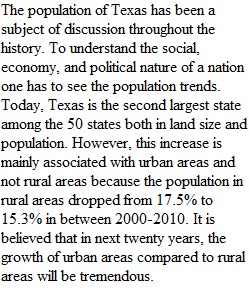


Q 1.The Total Score you received on Part 1 will be included here. This question's points plus the score you earn on the essay below will value this assignment's points at 50 once the points for Part 1B are tallied. 2.Given the data you have gathered in the first part of your proving ground assignment, I would like you to write a brief summary of Texas' population. Using at least FIVE of the data points you gathered in Part 1 of this assignment, address the following two points: 1. Discuss the implications of the data and what they mean for Texas over the next twenty years. 2. Provide a brief discussion of why Texas' political culture (the material you read about in Chapter 1 of your textbook) will present difficulties for addressing and overcoming the challenges discussed by Dr. Steve Murdock in his video. Your essay should be no less than 500 words and be grammatically correct, free from typos and spelling errors and conform to college- level writing expectations. It will be reviewed for plagiarism. You may use discussion points from both Dr. Murdock's presentation as well as your textbook, however, you are expected to write your own responses. There is no need to use materials from other sources or provide citations as the only sources you will use for this assignment are the video, the workbook from which you gathered your data, and Chapter 1 of your textbook.Unlike Part 1 of this assignment, you will only have one opportunity to submit this so please make sure you have submitted your best work.
View Related Questions